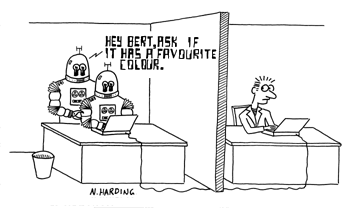So, today (June 23, 2011) marks the 99th anniversary of the birth of Alan Turing, British supergenius who played a critical role in winning World War II and is one of the founding fathers of computer science.
He was also gay, which was illegal Britain at the time. In 1952 he was prosecuted under the same law that had sent Oscar Wilde to gaol. He chose to undergo chemical castration (in the form of treatment with feminizing hormones) as an alternative to prison.
In 1954 he committed suicide in dramatic fashion. He died of cyanide poisoning, and was found lying in his bed with a half-eaten apple beside him. The speculation is that he had laced the apple with cyanide and was reenacting the apple scene from Snow White.
Turing’s earliest major contribution was the hypothetical Turing machine, which consisted of a very long piece of tape and a set of rules for manipulating the symbols on that tape. Turing showed that such a machine was, in principle, capable of performing any mathematical computation that can be represented as an algorithm. The Universal Turing Machine (a Turing machine capable of simulating any other Turing machine) provided a sort of proof-of-principle for the idea of general-purpose computers, and the tape-and-manipulator structure of the Turing machine is often cited as the prototype of the separation-of-hardware-and-software structure that pervades our computer lives today.
 |
| A Turing machine consists of a tape with symbols on it and a machine with a set of rules for reading and manipulating those symbols. And a bell. |
During World War II, Turing worked as a cryptanalyst and made major contributions to cracking the “Enigma” codes used by the German military. The success of Turing and his colleagues throughout the war gave the Allies a critical advantage, particularly during the early parts of the war, when the Germans had a significant military advantage.
After World War II, he introduced what we now call the “Turing test” for artificial intelligence. The idea is that a computer can be said to have achieved genuine intelligence if a human having a conversation with it could not tell that it was a computer. For the next forty-some years, this was considered to be the gold standard for the demonstration of human intelligence. Then came a flood of reality television, which demonstrated that many humans would not actually pass it.
During the last few years of his life, Turing turned his attention to certain problems in mathematical biology, including the curious fact that many plants seem to grow in patterns governed by the Fibonacci sequence. The whole phyto-Fibonacci thing is a weird and interesting phenomenon that will get its own dedicated post sometime soon.
In the meantime, happy birthday Alan Turing, and RIP.
Turing, A. M. (1950). Computing Machinery and Intelligence Mind, 59 (236), 433-460

Simon Singh has a great book called “The Code Book” that describes Turing’s work on the Enigma. Sounds like it took a genius to crack it, good thing Turing was British. Nice post!